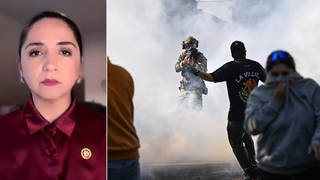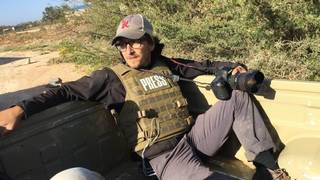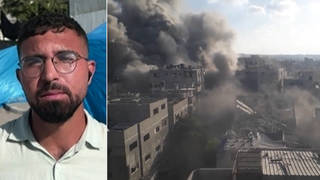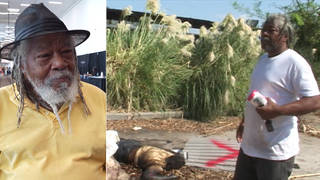
Guests
- James Ridgewayreports for Mother Jones magazine, and he is co-editor of Solitary Watch, a website that tracks solitary confinement and torture in American prisons.
Links
Even though Hurricane Irene prompted a series of extraordinary measures in New York City — a complete shutdown of the public transit system and mass evacuations on an unprecedented scale — officials did not take any steps to evacuate some 12,000 prisoners held in a city jail on Rikers Island. According to the New York City Department of Corrections website, more than three-quarters of Rikers Island’s 400 acres are built on landfill, which is generally thought to be more vulnerable to natural disasters. Mayor Michael Bloomberg said prisoners there were not in any danger, but human rights organizations condemned the city’s decision. Today also marks the sixth anniversary of another massive storm and a decision not to evacuate prisoners. It was August 29, 2005, when Hurricane Katrina led to the flooding of New Orleans, and prisoners in city and parish jails were left to fend for themselves. We speak with James Ridgeway, a reporter for Mother Jones magazine and founder and co-editor of Solitary Watch, a website that tracks solitary confinement and torture in American prisons. [includes rush transcript]
Transcript
AMY GOODMAN: Speaking of Hurricane Katrina, it is the anniversary of Hurricane Katrina, as well. Well, even though Hurricane Irene prompted a series of extraordinary measures in New York City—a complete shutdown of the transit system and mass evacuations on an unprecedented scale—officials did not take any steps to evacuate some 12,000 prisoners held in the city jail on Rikers Island.
Many residents used the city’s color-coded map to determine whether they lived in an evacuation zone. While Rikers Island was surrounded by areas where evacuation was either mandatory or recommended, the island itself was left, indicating—was left white, indicating there was no plan for it to be evacuated.
According to the New York City Department of Corrections website, more than three-quarters of Rikers Island’s 400 acres are built on landfill, which is generally thought to be more vulnerable to natural disasters.
During one of New York Mayor Michael Bloomberg’s many news conferences this weekend, a reporter asked him why the prisoners weren’t being evacuated. This is the Mayor.
MAYOR MICHAEL BLOOMBERG: There’s no reason to evacuate Rikers Island. It is higher than the Zone A areas, and it’s perfectly safe.
AMY GOODMAN: But human rights organizations condemned the city’s decision, with Vince Warren, the director of the Center for Constitutional Rights, saying it’s, quote, “appalling” and that the lives of prisoners were no less valuable than those of other New Yorkers.
Well, today does mark the sixth anniversary of another massive storm and decision not to evacuate prisoners. It was August 29th, 2005, when Hurricane Katrina led to the flooding of New Orleans, the nation’s 35th largest city. During and after that hurricane, prisoners in city and parish jails were also not evacuated, left to fend for themselves. Many died as a result.
To talk more about the prisoners in New York and New Orleans, we go to Washington, D.C., to speak with Jim Ridgeway, a journalist for Mother Jones magazine and founder and co-editor of Solitary Watch, a website that tracks solitary confinement and torture in American prisons.
Jim Ridgeway, we welcome you to Democracy Now! Talk about what the Mayor said, how he justified not evacuating the prisoners at the city jails located on Rikers Island.
JAMES RIDGEWAY: Well, in the first place, Amy, I don’t really see what whether it’s built on landfill or not has to do with this. It’s a moral issue. I mean, a lot of the people at Rikers Island are juveniles. There are other—a lot more are mentally ill. There are a lot of people there who are awaiting trial and who are innocent. There are people there who can’t make bail. So, you know, it’s the whole idea, that it’s like total insanity. Why wouldn’t you have a plan to get these people out, get everybody out of that place, in the midst of an emergency? I mean, here is this island. It sits up there in the East River. It’s exposed both to the east and to the west. And all New York did, and all the country did, was talk about storm surges. So, you know, who knows how high a storm surge might have come or might not have come?
But knowing what we know about Katrina and these guys left in cells, I mean, you realize that in Katrina prisoners were waist-high—the water was waist-high around them, you know, filthy water, you know, a lot of dirt and feces and so forth in it, and the guards just took a hike. They fled. Well, so they were left, essentially, to die in cages, in iron cages.
Well, in this particular instance, in Rikers, fortunately nothing happened. But it’s not just the people in the prison. I mean, there are thousands of people who work there. And one would think that the unions representing the guards, the corrections officials, would be up in arms about this, and the families of the corrections officials. I mean, what’s the deal here? Are they going to be just left there, too? I mean, they’ve got 12,000 prisoners, plus I don’t how many thousand corrections officers. It’s a moral issue for the City of New York.
AMY GOODMAN: What is being done about this right now? I mean, now the hurricane has passed. Even the low-lying areas were not hit in New York the way it was expected. Other areas severely affected, you know, up in Vermont, etc. Are you calling on the city to have a plan now?
JAMES RIDGEWAY: Well, yes, the city ought to have a plan, but you would think that the city council would be up in arms, that the members of Congress. I mean, these jails and prisons are often financed both by the state and by the federal government through various programs. I mean, where are the senators? Where are the congressmen? I mean, there ought to be some kind of oversight. There surely ought to be a plan, and not just some sort of paper, you know, go-to plan, but a real plan.
Now, New York State has a very unusual situation, because there’s something there called the Correctional Association. That association has the right to go into prisons. It’s very much unlike other states. And so, I don’t know whether they’ve done a report, but you would certainly think that they would immediately heave to and do a report on what’s going on there. I mean, I don’t see why this prison should operate if it doesn’t have an evacuation plan for emergencies. I mean, what are you going to do with 16-year-old kids or people who are mentally ill? I mean, you just going to let them die in an emergency there? I think the Mayor’s response is ridiculous.
AMY GOODMAN: Looking at other cities and states, North Carolina, for example, evacuated over 1,300 prisoners before Irene struck, New Jersey, 500 prisoners, Jim Ridgeway.
JAMES RIDGEWAY: Well, yeah. I mean, some places, I mean, have learned or reinforced their concepts as a result of Katrina. I mean, Katrina was a wake-up call, or ought to have been. I mean, the ACLU put out this really excellent report describing all this. And you would think that federal, state, local officials would be aware of this aspect of a hurricane or a tornado or other natural disasters.
AMY GOODMAN: Well, Jim Ridgeway, I want to thank you very much. We’re going to link to the ACLU report, as well as yours. Jim Ridgeway reports for Mother Jones magazine and is co-editor of Solitary Watch, a website that tracks solitary confinement in American prisons.












Media Options